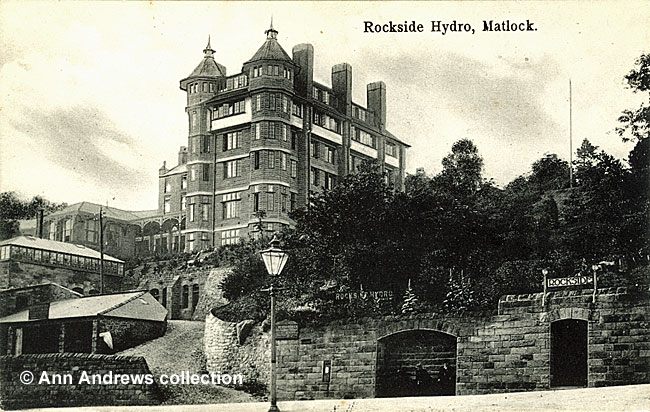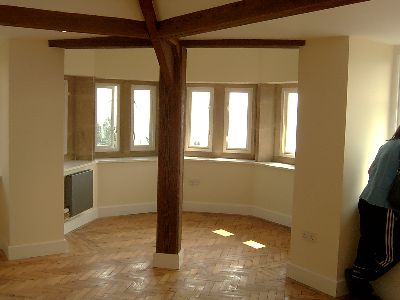|
Images Index> Matlock, 20th and 21stC Images> This page |
| Matlock: Rockside Hydro |
| Matlock : Twentieth Century Photographs, Postcards, Engravings & Etchings |
|
|
|||||||||||||||
Rockside was opened as an hydropathic establishment in 1860 by Charles Rowland and his wife, who were from Burton Upon Trent and friends of John Smedley[1]. Mr. Rowland was interested in numerous enterprises in the district and was a Director of the Matlock Tram Company when it was set up[2]. The tram terminus was immediately below Rockside, at the top of Rutland Street. In the 1860s a couple of other names were mentioned in connection with the hydro. A Mrs. Morrish advertised Rockside as a delightful winter residence in 1865[3]. In 1866 "Rockside Sanatorium" (established 1860), was said to be "replete with every convenience for the most skilful application of the water cure, and the comfort of its inmates". The new proprietor was Mr. Walter Clement Wyles, a young man from Allesley in Warwickshire[4]. The Rowlands took over again as hydropathists in 1867, dividing their time between Rockside and Matlock House[5]. Their physician was J. Cash, Esq., M.R.C.S.[4]. He had been involved since at least 1866, if not earlier[6]. Mr. Rowland was followed at Rockside by James Burton, who had married the Rowlands' niece, and then by William Atkins and his sister who became the proprietors in 1880[7]. It had been enlarged by the time the Atkins' took over the business and could accommodate 100 guests. A new drawing-room had been built and a new billiard room with a full sized table had been installed. In addition the grounds had been landscaped and croquet, lawn tennis and other games were also available[7]. The Atkins celebrated their last Christmas at Rockside in 1892[8]. A year later Mr and Mrs John Burton Bardsley, the new lessees, were enjoying Christmas in "the good old English style"; they had a full house and the company was deemed "jovial"[9]. There were then about 70 bedrooms. At the end of that year a proposal to turn the concern into a limited liability company with a capital of £21,000 was reported in the press. A new front was planned, along with passenger lifts to all floors and the baths were to be remodelled[9]. A few days afterwards, at the very beginning of 1894, a company was formed "to purchase, extend and carry on the Hydropathic Establishment of Rockside". One of the reasons given for Charles Rowland, the founder and owner of Rockside, not personally undertaking the extensions that were necessary was because of his advanced age. The Directors were named as: Charles Rowland, Matlock Back, Chairman; John Burton Bardsley, Matlock Bank Hydropathist (was to join the board after allotment as Managing Director); John Edward Lawton, Woodbank, Duckinfield, Cotton Spinner and four others who were not local men. Their bankers were the Sheffield and Rotherham Joint Stock Banking Co., Limited of Matlock[10]. Mr. Rowland was to retain a large number of shares. In July 1894 it was announced that Rockside was under new management and that the bedrooms had all been refurnished[11], a sale of the unwanted furniture having taken place in May[12]. The Goodwin family had taken over running the hydro and advertised excellent cuisine[11]. John and Eliza (née Moore) Goodwin were neighbours of the Rowlands' and lived at Wolds Farm, the family farm[13]. They had married at St. Giles in 1855 and John died at the farm in 1887[14]. Anne Eliza Goodwin, the couple's eldest daughter, managed the hydro and Eliza lived with her. Another daughter, Dora, acted as housekeeper at first and then as secretary whilst a third daughter, Marie, had just passed her final examinations to become a doctor[15]. Marie Goodwin married Dr. Albert L'Estrange Orme in 1900 at Matlock Bank Congregational Chapel and the couple lived at The Red House on Dale Road[16]. They were both involved with the medical side of the treatments at Rockside. Although Albert Orme died in 1909[14], his widow continued her association with Rockside all her life[11]. Matlock Council hoped to straighten the tramway line in 1898 and applied to the Board Trade for a Provisional Order[17], which was passed by both Houses of Parliament[18]. Messrs Goodwin were also approached to see if they would permit the Council to cut through their grounds and create an extension to the existing tramway, but they were unable to accept the idea[17] so the extension was never built. In May 1903 builders and contractors were invited to submit tenders to erect a new wing at Rockside by the architects Messrs Barry Parker and Raymond Unwin of the Quadrant, Buxton[19]. This was for the tower that is still standing today. In 1906 it was reported that the extensions, costing nearly £20,000, were underway[20]. In between times Mr. John Godfrey Goodwin, who was both a soap manufacturer and the proprietor of the Rockside at the time, was to comment on the proposals to supply gas to the town. He observed that because of the altitude of the hydro they suffered from the smoke from the chimneys lower down the hill; he believed that if power gas were supplied it would do away with a great deal of the nuisance[21]. He was not alone in criticising the chimney smoke.
The 1909 visitor noted that the establishment is situated on one of the highest points of Matlock and added that the view from the grounds and windows is one of extreme beauty. "Below nestles the little town of Matlock, while all around one gazes over the magnificent scenery which has made Matlock and Derbyshire so famous"[22]. The views are something many commented on over the years.
Turret room, designed by Parker& Unwin and
refurbished 2005.
These double, or twin, fireplaces are on all
floors. Photographed 2005.
There is more about Rockside
|
||||||||||||||||
|
1. "Rockside Hydro, Matlock," published by Kingsway (WHS logo), No.S14059. Real Photo Series. Undidvided back. Not posted. 2. "Rockside Hydro, Matlock". Boots Cash Chemists "Pelham" Series postcards, No.947. Printed in Prussia. Unused. The stamp box shows: Affix Half Penny Stamp Inland. Penny Stamp Foreign. Not all of the Pelham series were numbered, but another card was posted in 1906. Both postcards in the collection of and provided by and © Ann Andrews. Photographs of the restored building donated to and © for the sole use of this website. Researched, written by and © Ann Andrews. Intended for personal use only. |
||||||||||||||||
References (coloured links are to transcripts or more information elsewhere on this web site): [1] His first trade directory entry appeared in White's Directory 1862, see Baths. An advertisement in "The Staffordshire Advertiser" of 26 April 1862 must be one of the earliest, if not the earliest, to be published. The terms were then 25s. 6d. to 31s. 6d. per week. [2] See Bank Road & the Steep-Gradient Tramway [3] "Birmingham Daily Post", 20 November 1865. [4] "The Bradford Observer", Thursday, 21 June, 1866. The terms were from one and a half to two guineas week. It is difficult to work out how Walter Clement Wyles became involved in hydropathy. In 1961, aged 17, he was Mercantile Clerk With Worsted Yarn Spinner in Bradford. He got into financial dificulties whilst at Rockside (see Names in the London Gazette, 1867 - two entries. He then turned his hand to teaching; in 1871 he was in Rickmansworth and in 1881 he had returned to his father's school at Allesley. [5] "Aris's Birmingham Gazette", 29 June 1867. [6] Josiah Cash was living with Dr. Adams at Matlock Bridge in 1861 and was still in Matlock Bridge in the 1871 census. Hall's "Days in Derbyshire", 1863 shows him with his own establishment. [7] "Derbyshire Times ", 6 November 1880. "The famous Hydropathic and Boarding Establishment, Rock Side, Matlock Bank, has come under new management". [8] "ibid.", 31 December 1892. This was the last time William Atkins is reported at Rockside. A newspaper published about three years later say he was there for "a dozen years". His sister had retired and he was running Rockside with his wife at this time. [9] "Derbyshire Times and Chesterfield Herald", 30 December 1893. [10] "Derbyshire Times and Chesterfield Herald", 3 January 1894. John Barton Bardsley and his young family moved to Dore at some stage between 1895 and 1900. The other director named above, Charles Edward Lawton, was involved with Masson Mill (see Arkwright & His Cotton Mill in Matlock Bath) and also built Woodbank in Matlock Bath (later Cromford Court). [11] "Derby Daily Telegraph", 18 July 1894. [12] "Derbyshire Times and Chesterfield Herald", 28 April 1894. This took place at the Matlock Bridge salerooms of Mr. Joseph Hodgkinson, the auctioneer, who had been instructed by the Messrs. Goodwin. [13] The Goodwin family appear in the following census returns: 1841 | 1851 | 1861 | 1871 | 1881 | 1891 | 1901. Also see Strays (Surnames G). [14] See references for Wills of John Goodwin and Albert L'Estrange Orme. Dr. Orme died 11 July 1909. [15] "Derbyshire Times and Chesterfield Herald", 12 May 1894. [16] In 1901 the Ormes were living on Dale Road. [17] "Derbyshire Times and Chesterfield Herald", 12 November 1898. [18] Waite, Glynn (2012) "The Matlock Cable Tramway", Pynot Publishing. ISBN 9780956270658. [19] "Derbyshire Times and Chesterfield Herald", 16 May 1903. [20] "ibid.", 24 March 1906. [21] "Derby Daily Telegraph", 15 June 1904. John Godfrey Goodwin died at Derby House Nursing Home in Buxton on 27 Jul 1947. [22] "Derbyshire Courier", 4 January 1910. |




























